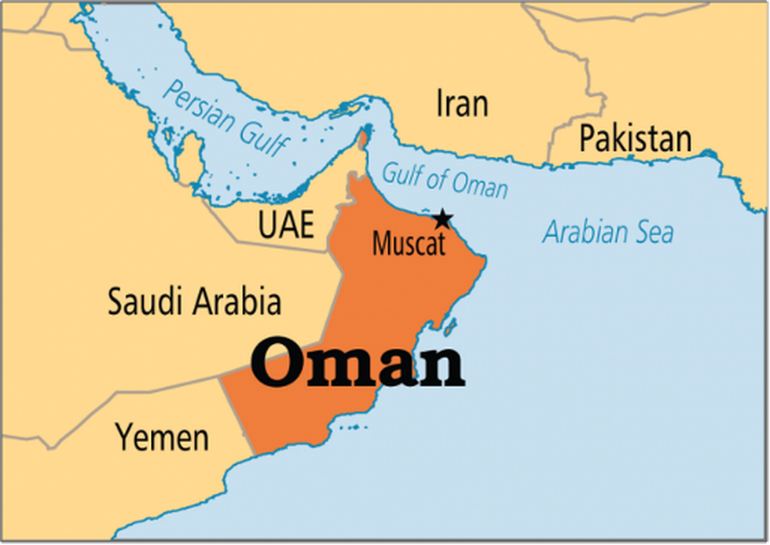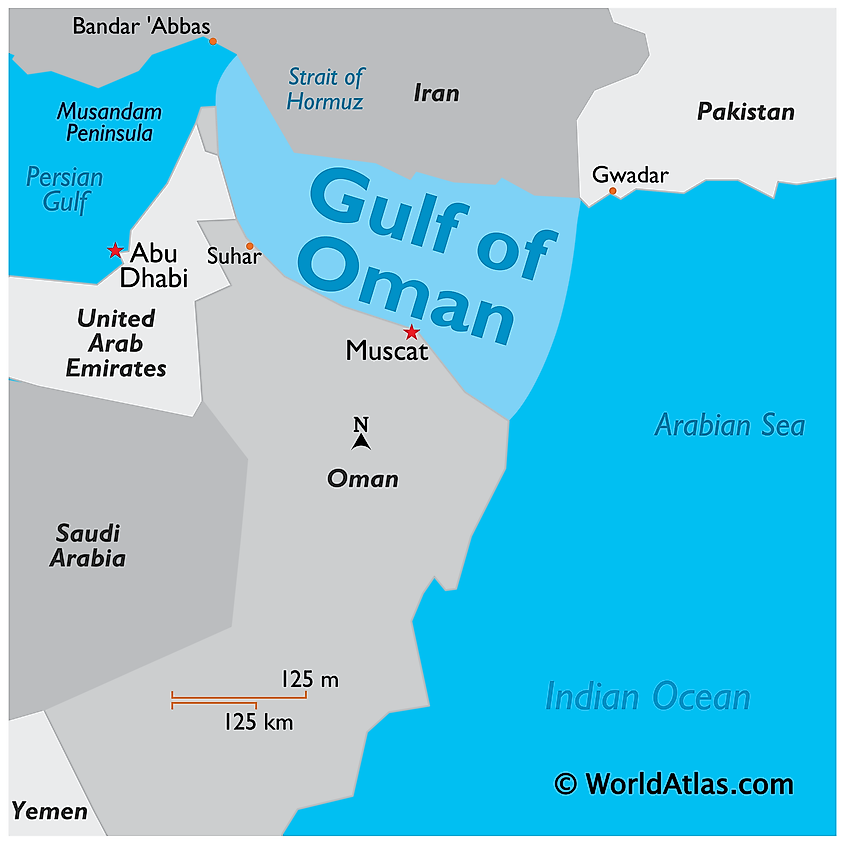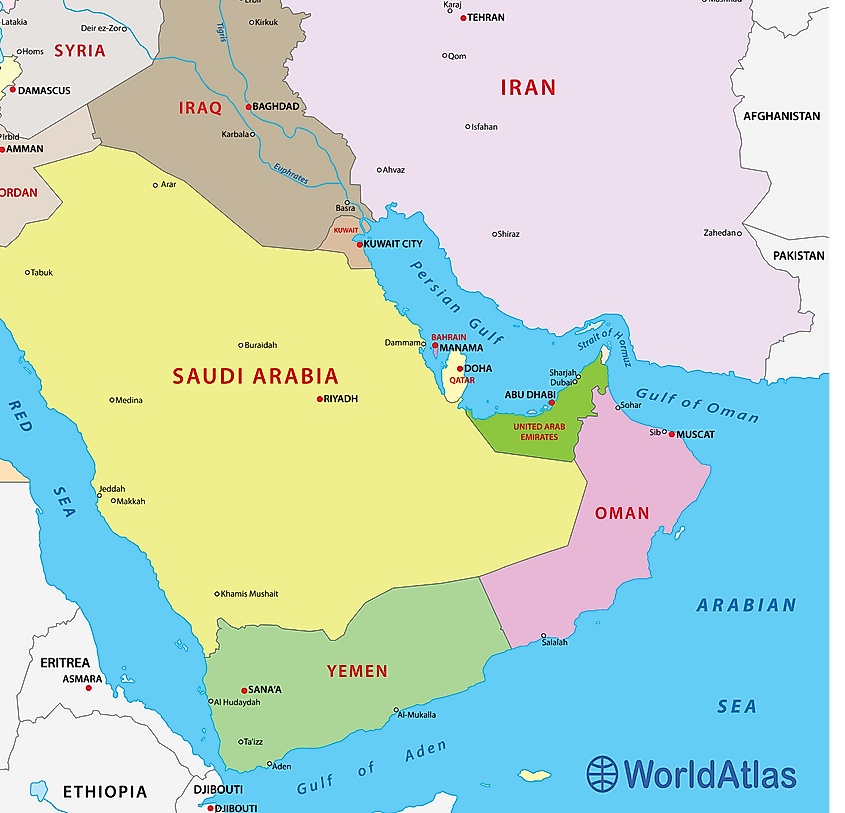Description

Disclaimer: Copyright infringement not intended.
Context
- Iran's navy seized a Marshall Islands-flagged oil tanker with 24 Indian crew members in the Gulf of Oman.
Gulf
- A gulf is a large inlet from the ocean into the land. Gulfs are formed as a result of plate tectonics and are often connected to the ocean by narrow water passages known as straits.
Gulf of Oman
- The Gulf of Oman is a western extension of the Arabian Sea.
Location
- It is situated in the Middle East between the countries of Iran, Oman, and the United Arab Emirates.
- Gulf of Oman is located in the Northwestern Indian Ocean.

Connector
- The Gulf connects the Arabian Sea with the Strait of Hormuz, which then empties into the Persian Gulf.
Border
- The Gulf of Oman is bordered by Pakistan and Iran in the north; by the United Arab Emirates in the west and by Oman in the south.
Widest Point
- The Gulf of Oman is about 320 km wide at its widest point between Cape al-Hadd in Oman and the Gwadar Bay on the Iran-Pakistan border.

Islands in Gulf of Oman
- Some of the significant islands that are located in the Gulf of Oman include Sheytan Island, Al Fahal Island, Dimaniyat Islands, and the Sawadi Islands.
Bordering Countries and Cities
- The countries bordering the Gulf of Oman include Iran, Oman, the United Arab Emirates, and Pakistan.
- Muscat, the capital of Oman, is located on the coast of the gulf.
- The major Iranian cities that are located on the coastline of the Gulf of Oman are Gawadar Bay, Jask, and Chabahar.
International Shipping Ports
- The major international shipping ports that are situated in the Gulf of Oman include
- Port Sultan Qaboos Muttrah in Muscat, Oman;
- Chabahar Port in Iran;
- the Port of Fujairah and
- Khor Fakkan Container Terminal in the United Arab Emirates.

International Trade
- The Western side of the gulf connects to the Strait of Hormuz, a strategic route through which a third of the world's liquefied natural gas and 20% of global oil consumption passes from Middle East producers.
Ecology
- In 2018, scientists confirmed the Gulf of Oman contains one of the world's largest marine dead zones, where the ocean contains little or no oxygen and marine wildlife cannot exist.
List of Important Gulfs in the World
- Gulf of Aden, off the southwestern corner of the Arabian Peninsula
- Gulf of Alaska, in the Pacific Ocean, south of the state of Alaska
- Albay Gulf, in the southern part of Luzon, Philippines
- Ambracian Gulf, of the Ionian Sea in northwestern Greece
- Amundsen Gulf, in the Arctic Ocean, northwest of Canada
- Gulf of Aqaba, in the northern end of the Red Sea
- Argolic Gulf, of the Aegean Sea off the east coast of the Peloponnese, Greece
- Asid Gulf, in the municipality of Milagros, Masbate, Philippines
- Gulf of Bahrain, inlet of the Persian Gulf on the east coast of Saudi Arabia
- Gulf of Boothia, in Nunavut, Canada
- Gulf of Bothnia, part of the Baltic Sea between Sweden and Finland
- Gulf of Burgas, Black Sea, Bulgaria
- Gulf of Cádiz, part of the Atlantic Ocean off the southern border of Spain and Portugal
- Gulf of California, in the Pacific Ocean in northwestern Mexico
- Cambridge Gulf, on the north coast of Western Australia
- Gulf of Carpentaria, in Northern Australia
- Gulf of Cazones, in southern Cuba
- Gulf of Corinth, of the Ionian Sea separating the Peloponnese from western mainland Greece
- Gulf of Corryvreckan, off the west coast of mainland Scotland
- Davao Gulf, in Davao City, Mindanao, the Philippines
- Exmouth Gulf, gulf in North West Australia
- Gulf of the Farallones, between the Farallon Islands and the mainland coast of California, United States
- Gulf of Finland, between the southern coast of Finland and the northern coast of Estonia in the Baltic Sea
- Gulf of Fonseca, of the Pacific Ocean in El Salvador, Honduras, and Nicaragua
- Gulf of Gabès, gulf on Tunisia's east coast in the Mediterranean Sea, off North Africa
- Gulf of Genoa, inside the Ligurian Sea on the northwestern coast of Italy
- Gulf of Gonâve, in the Caribbean Sea off the coast of Haiti
- Gulf of Guinea, in the Atlantic Ocean off the coast of Equatorial Africa
- Gulf of Hammamet, in northeastern Tunisia
- Hauraki Gulf, of the North Island of New Zealand
- Gulf of Honduras in the Caribbean Sea between Belize, Guatemala, and Honduras
- Gulf Islands close to Vancouver Island and within the Strait of Georgia within British Columbia
- Gulf of İzmir in the Aegean Sea between Turkey and Greece
- Gulf of Khambhat in the Arabian Sea, formerly known as the Gulf of Cambay
- Gulf of Kuşadası
- Gulf of Kutch in the Arabian Sea
- Lagonoy Gulf in the Philippines
- Leyte Gulf, in Eastern Visayas, Philippines
- Lingayen Gulf, off western Luzon, the Philippines, in the South China Sea
- Gulf of Lion, a bay on the Mediterranean coastline of Languedoc-Roussillon and Provence in France
- Gulf of Maine, off the States of Maine, New Hampshire, and Massachusetts in the United States, and the Canadian Provinces of New Brunswick, and Nova Scotia in the Atlantic Ocean
- Malian Gulf
- Gulf of Mannar, between India and Sri Lanka
- Gulf of Mexico, between Mexico, the United States, and Cuba
- Gulf of Morbihan, a natural harbor on the coast of the Département of Morbihan in the south of Brittany
- Gulf of Nicoya, in Costa Rica. Central America.
- Gulf of Odessa
- Gulf of Oman, between the southeastern Arabian Peninsula, Iran, Pakistan and Arabian Sea.
- Gulf of Oristano, near Oristano on the Western Sardinian coast
- Gulf of Panama in the Pacific Ocean south of Panama
- Panay Gulf, in the Western Visayas, Philippines
- Gulf of Paria, in the Caribbean Sea between Trinidad and Tobago and Venezuela
- Persian Gulf between Iran and the Arabian Peninsula
- Peter the Great Gulf in the Sea of Japan
- Ragay Gulf in the Philippines
- Gulf of Riga in the Baltic Sea
- Gulf of Roses, the most northeastern bay on the Catalan coast
- Gulf of Saint Lawrence, the world's largest estuary and the outlet of the Saint Lawrence River into the Atlantic Ocean
- Gulf St Vincent, Separated from Spencer Gulf by the Yorke Peninsula
- Saronic Gulf, which extends into Greece from the Aegean Sea.
- Gulf of Sirte, just north of Libya in the Mediterranean
- Spencer Gulf, near Port Lincoln, South Australia
- Gulf of Suez in the northern end of the Red Sea, leading to the Suez Canal
- Gulf of Taranto in the Mediterranean between the toe and the heel of Italy
- Gulf of Tartary between Russia and Sakhalin
- Gulf of Thailand just south of Thailand in the Pacific Ocean South China Seas
- Gulf of Tonkin just east of North Vietnam in the Pacific Ocean
- Gulf of Tunis in the Mediterranean off the coast of Tunisia
- Gulf of Varna, Black Sea, Bulgaria
- Gulf of Venice, at the head of the Adriatic Sea between Italy, Slovenia and Croatia
- Moro Gulf, the largest gulf in the Philippines off the coast of Mindanaoa
|
PRACTICE QUESTION
Q. Which of the following statements are incorrect with reference to important Gulfs in the world?
a) Gulf of Oman connects the Arabian Sea with the Strait of Bab-el-Mandeb.
b) The Gulf of Bothnia is part of the Baltic Sea between Sweden and Finland.
c) The Gulf of Tonkin is an arm of the Pacific Ocean.
d) Gulf of Mexico is the largest gulf in the world.
1. a and b only
2. a and c only
3. a and d only
4. None of the above.
Correct Answer: Option 2
The Gulf of Tonkin is a gulf at the northwestern portion of the South China Sea.
|
-min.jpg)
https://www.seattletimes.com/business/iran-tv-airs-footage-of-commandos-seizing-us-bound-tanker/?amp=1












